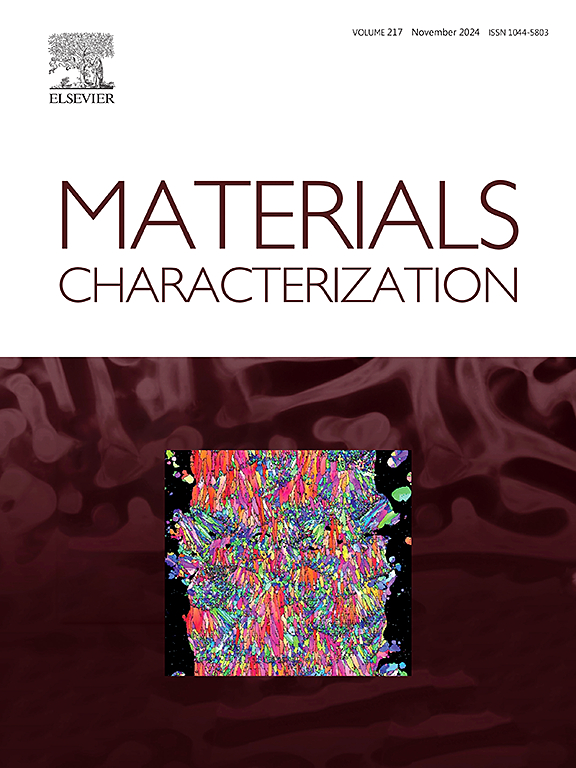Effect of Sc and Zr co-microalloying on microstructure evolution and mechanical properties of 7085Al alloy
IF 4.8
2区 材料科学
Q1 MATERIALS SCIENCE, CHARACTERIZATION & TESTING
引用次数: 0
Abstract
In this paper, the trace addition of Sc and Zr in 7085Al alloy significantly improved strength and ductility at room and high temperature. The Al3(Sc, Zr) precipitates with Sc-rich core and Zr-rich shell and their size ranged from 20 to 80 nm, such special structure made Al3(Sc, Zr) precipitates owned excellent thermal stability. Hence Al3(Sc, Zr) precipitates can still effectively pin grain boundaries and hinder dislocation movement at high temperature. The dislocation accumulation caused by Al3(Sc, Zr) precipitates during hot rolling promoted dynamic recrystallization. The average grain size of α-Al grains was increased with the increase of rolling reduction and the average size grains of 7085Al- 0.3Sc- 0.2Zr alloy with 90 % rolling reduction were decreased to 3.2 μm. Compared with 7085Al matrix alloy under 90 % rolling reduction, the average grains size was decreased to 70.3 %. Al3(Sc, Zr) precipitates had good strengthening effect at both room and high temperature. The UTS, YS and elongation of 7085Al- 0.3Sc- 0.2Zr alloy at 25 °C were increased to 611.7 MPa, 523.8 MPa and 13.8 % respectively, the UTS, YS and elongation of 7085Al- 0.3Sc- 0.2Zr alloy at 300 °C were increased to 223.4 MPa, 201.2 MPa, 27.9 % respectively. The increase of mechanical properties was attributed to the synergistic strengthening effect induced by the fine grain strengthening and the Orowan bypassing strengthening mechanisms.
Sc和Zr共微合金化对7085Al合金组织演变和力学性能的影响
在7085Al合金中添加微量的Sc和Zr,可以显著提高7085Al合金的室温和高温强度和塑性。Al3(Sc, Zr)相芯部富Sc,壳部富Zr,尺寸在20 ~ 80 nm之间,这种特殊的结构使得Al3(Sc, Zr)相具有优异的热稳定性。因此,Al3(Sc, Zr)相在高温下仍能有效地钉住晶界,阻碍位错运动。热轧过程中Al3(Sc, Zr)析出引起的位错积累促进了动态再结晶。α-Al晶粒的平均晶粒尺寸随着轧制压下量的增加而增大,轧制压下率为90%的7085Al- 0.3Sc- 0.2Zr合金的平均晶粒尺寸减小至3.2 μm。与轧制压下90%的7085Al基合金相比,平均晶粒尺寸减小了70.3%。Al3(Sc, Zr)相在室温和高温下均有良好的强化效果。7085Al- 0.3Sc- 0.2Zr合金在25℃时的UTS、YS和伸长率分别提高到611.7 MPa、523.8 MPa和13.8%;7085Al- 0.3Sc- 0.2Zr合金在300℃时的UTS、YS和伸长率分别提高到223.4 MPa、201.2 MPa和27.9%。力学性能的提高是由细晶强化和Orowan旁路强化机制共同作用的结果。
本文章由计算机程序翻译,如有差异,请以英文原文为准。
求助全文
约1分钟内获得全文
求助全文
来源期刊

Materials Characterization
工程技术-材料科学:表征与测试
CiteScore
7.60
自引率
8.50%
发文量
746
审稿时长
36 days
期刊介绍:
Materials Characterization features original articles and state-of-the-art reviews on theoretical and practical aspects of the structure and behaviour of materials.
The Journal focuses on all characterization techniques, including all forms of microscopy (light, electron, acoustic, etc.,) and analysis (especially microanalysis and surface analytical techniques). Developments in both this wide range of techniques and their application to the quantification of the microstructure of materials are essential facets of the Journal.
The Journal provides the Materials Scientist/Engineer with up-to-date information on many types of materials with an underlying theme of explaining the behavior of materials using novel approaches. Materials covered by the journal include:
Metals & Alloys
Ceramics
Nanomaterials
Biomedical materials
Optical materials
Composites
Natural Materials.
 求助内容:
求助内容: 应助结果提醒方式:
应助结果提醒方式:


